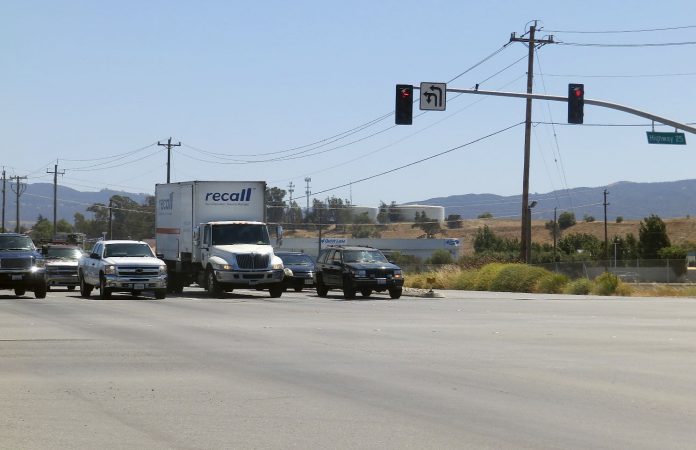Rough roads and crowded highways took center stage at a congenial lunch-and-learn community discussion session held by the San Benito County Chamber of Commerce July 12.
Chamber members met at the stylish, new Marriott Hotel at 390 Gateway Drive in Hollister to hear from city and county officials about the state of local roads. The event garnered much interest from the business people whose bottom line are impacted by the condition of the county’s infrastructure, according to Chamber CEO Juli Vieira, the nonprofit had to turn away eight people because the lunch was fully booked.
Speakers included Council of San Benito County Governments (COG) Executive Director Mary Gilbert, Hollister Management Services Director Mike Chambless, County Management Analyst Louie Valdez and County Supervisor Mark Medina.
Gilbert provided overview of the transportation policy-making landscape and explained that the role of the COG, the county’s regional transportation agency, is to focus on long-range planning.
“We’re not so much down on the individual roads, but we try and help the local jurisdictions as much as we can,” Gilbert said. “There’s also some funding that comes through COG that we then allocate to local jurisdictions. We’re a partner to many agencies.”
Gilbert provided an overview of transportation funding, which includes fuel excise taxes, truck weight fees and vehicle registration fees. She touched on Measure P, a countywide half-cent transportation sales tax that failed to pass during the June 2016 primary election. Neighboring Santa Cruz, Monterey and Santa Clara Counties were more successful in passing their own 30-year sales tax increases in November.
“Unfortunately that did not pass, but we’re still looking ahead and you may hear more in the next few years as we look toward the 2020 election for a sales tax measure,” Gilbert said. “That is a great tool we can have in the toolbox to help us leverage those state and federal funds.”
While the Highway 156 expansion project is fully funded, Gilbert said construction isn’t expected to begin until Fall 2019. Local funds going to the project include traffic impact fees totalling around $9.6 million.
Back in 2008, Caltrans approved an environmental impact report for the project that would expand the congested thoroughfare from San Juan Bautista to a point close to Hollister into a four-lane, at-grade expressway.
As of 2015, the cost of the project was estimated at $47.2 million for construction and $81.2 million total. According to a county transportation report, funding sources included local impact fees, state funds and inter-regional funds.
As for Highway 25, Gilbert said that $180 million in funding is needed.
“We are collecting traffic impact fees for that and looking toward other local sources, including potentially the sales tax measure,” she said. “It’s a lot of money.”
Chambless delivered a report on road maintenance and repair. He told attendees the City of Hollister has allocated $2.4 million for an assortment of road related issues.
“Of that, I’m going to be responsible for $200,000 of overtime, $125,000 for thermoplastic markings, $150,000 for crack filling, $50,000 for pothole repair, $75,000 for [American Disabilities Act] improvements and $15,000 to replace street signs,” Chambless said. “That left behind $1.7 million for a road project.”
Chambless said so far, city discussions on how to spend the $1.7 million has centered on fixing San Felipe Road, but nothing’s been confirmed, planned or sent to the Hollister City Council for approval.
“We’re looking at that $1.7 million, repairing the patches we have on San Felipe Road from the airport all the way up to Fourth Street,” he said. “Putting what’s called a cap seal over the top, which is new oil and rock, on all four lanes.”
If the city decides to fix San Felipe Road and there’s money leftover, Chambless said it could go to South Street between San Benito Street and West Street.
“That section in there is awful. A lot of people drive on it.”
There are 673 miles of roads in San Benito County.
“The study that was done by Pavement Engineering Systems last year estimated that the approximate cost to maintain or repair all the roads in San Benito County is going to cost about $398 million,” Valdez said. “Obviously, the county doesn’t have it. With the Federal Highway Trust Fund not being funded we’re not going to get it anytime soon. The state gas tax that we received last year, which was approximately $118,000, is not going to be nearly sufficient to address those needs.”
The county is expected to receive $660,000 in the first year of funds from Senate Bill 1, which increased state gas taxes and vehicle license fees to raise funds for the state highway system and local roads, passed in the state legislature earlier this year.
The county has to decide where the money will be best spent, Valdez said. The engineering department is currently undertaking a cost allocation study to identify the roadways to be fixed.
Based on the Pavement Condition Index, which rates roads on a scale from one to 100, the average condition of county roads is around 38, which is considered poor, Valdez said.
“Where you want to be as a jurisdiction, as a community is right around 70.”
While the county is conducting a study on the impact of trucks on county roads and updating impact fees, Valdez said tough decisions are coming for county supervisors over the next couple years.
“We’re doing our very best to address the needs of the community by making sure we provide the board with the best possible information,” he said.










